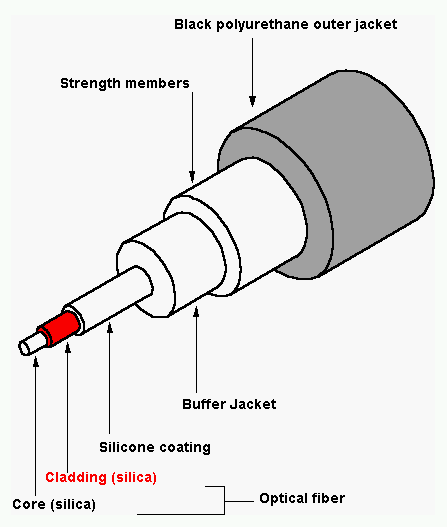The same way as copper cables, fiber cables vary in specifications, mainly depending on the applications they are designed for. Variations might affect core diameter, materials used, and environment cable could be used in. In order to better understand how fiber cable works, one should have a look at its components (see Figure 1). When stripping optical fiber cable of its layers, following components can be observed:
- Outer jacket;
- Optional protection from physical damage;
- Strength members;
- Buffer;
- Optical fiber stand.
Each optical fiber stand has three components inside:
- Core;
- Cladding;
- Coating.
Size of the core is varying between 8 and 63 microns. Pieces of the strand are so tiny they can easily penetrate skin and in some cases travel through human body with blood vessels. This is one more reason why installation should be done by professionals using specially intended gear.

Figure 1. Structure of the optical fiber cable.
Core and cladding are typically made of glass or plastic. Most important specification of the core is the index of refraction which is the value for light bending passing through the material and for the speed of that light could travel through material with. Cladding is having lower refractive index than the core. It allows light to stay inside the fiber and not escape into cladding, since it will be reflected.
Coating is simply a protective layer that is protecting core and cladding from the fracture.
Whether the fiber is single mode or multi-mode is defined by the thickness of the fiber optic stand. Thin core would support only single pathway for the light. Thicker core means more angles for input signal, thus being able to transmit data in multiple paths and modes.
Single mode fiber have some additional limitations due to nature of the cable. The concentrated laser is required, which is able to send signal precisely through such thin media. Every connection require precision to connect small diameter fibers, and hold them in position which affects cost of installation. Single fibers are mostly used for backbone and other long-distance parts of the application.
On the other hand, multi-mode fiber is having larger diameter core, which allows using cheaper lasers and LEDs as a source. Having larger cores simplifies the task of connecting fibers. All these points facilitate manufacturing process and reduce production costs. However, cheaper components have negative effect on both transmission distance and bandwidth. That makes multi-mode solutions better suited for the short connections in the network.
The materials used for fibers vary depending on the type of fiber. For smallest diameter single-mode cables the step-index glass is used. It is typically narrow core (8.3 microns) with the 125 microns cladding, which makes cable size manageable. For the multi-mode fiber there are two options for material for the core. First, is the graded index glass of 50 or 62.5 microns core. It is designed for the laser-driven 1-100 Gbps applications. Second, is the multi-mode plastic with diameter from 50 microns and up. This is the lowest quality fiber and typically for short distances or visible light decorations.


